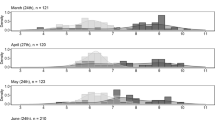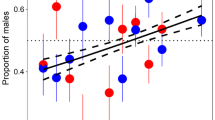Summary
Observed changes in maternal investment due to an environmentally induced decrease in food supply (the 1983 El Niño-Southern Oscillation) are compared witha priori predictions for the California sea lion (Zalophus californianus). Changes in behavior, growth and mortality of off-spring were also examined. Data collected in the first two months postpartum for the years before (PRE), during (EN), and the two years after (POST1 and POST2) the 1983 El Niño indicate that females initiated postpartum feeding trips earlier during the food shortage, and spent more time away on individual feeding trips in both the El Niño year and the year after. Perinatal sex ratios (♀:♂) in the years PRE, EN, POST1 and POST2 were 1:1, 1.4:1, 1.1:1 and 1:1.4, respectively. Fewer copulations were observed during the El Niño year, but this difference was not statistically significant. Pups spent less time suckling in the food shortage year and the year following, but attempted to sneak suckle more. Pups were less active and played on land less in the El Niño and following year. Finally, maternal investment as measured by milk intake of offspring was decreased, pups grew more slowly, and suffered increased mortality during the food shortage year. Despite expected sex differences in maternal investment and pup behavior in response to food shortage, there were no sex-biased differences in response in either females or pups. As expected, the food shortage did not affect adult males since they migrate north during the non-breeding season where the environmental perturbation was less severe.
Similar content being viewed by others
References
Antonelis GA, Fiscus CH, DeLong RL (1984) Spring and summer prey of California sea lions,Zalophus californianus, at San Miguel Island, California, 1978–79. Fish Bull 82:67–76
Barber RT, Chavez FP (1983) Biological consequences of El Niño. Science 222:1203–1210
Bartholomew GA (1967) Seal and sea lion populations on the California islands. In: Proceedings of the Symposium on the Biology of the California Islands, Santa Barbara Botanic Garden, pp 229–244
Bartholomew GA, Hubbs CL (1952) Winter population of pinnipeds about Guadalupe, San Benito, and Cedros Islands, Baja, California. J Mamm 33:160–171
Bigg MA (1973) Census of California sea lions on southern Vancouver Island, British Columbia. J Mamm 54:285–287
Cane MA (1983) Oceanographic events during El Niño. Science 222:1189–1202
Costa D, Thorson S, Feldkamp S, Gentry R, DeLong R, Antonnelis G, Croxall J (1985) At sea foraging energetics of three species of pinniped. Fed Proc 44:1000
Dayton PK, Tegner MJ (1984) Catastrophic storms, El Niño, and patch stability in a southern california kelp community. Science 224:283–285
Dasmann RF, Taber RD (1956) Behavior of columbian black-tailed deer with reference to population ecology. J Mamm 37:143–164
Fielder PC (1984) Satellite observations of the 1982–83 El Niño along the U.S. Pacific coast. Science 224:1251–1254
Fiscus CH, Baines GA (1966) Food and feeding behavior of Steller and California sea lions. J Mamm 47:195–200
Gentry RL, Kooyman GL (1986) Fur seals: Maternal strategies on land and at sea. Princeton University Press, Princeton, 291 pp
Guilbert HR, Goss H (1932) Some effects of restricted protein intake on the estrous cycle and gestation in the rat. J Nutr 5:251–265
Hafez ES (1974) Reproduction in farm animals. Lea and Febiger, Philadelphia, 480 pp
Hancock D (1970) California sea lion as a regular winter visitant off the British Columbia coast. J Mamm 51:614
Heath CB, Francis JM (1983) Population dynamics and feeding ecology of the California sea lion with applications for management. SW Fish Center Admin Report LJ-83-04C
Heath CB, Francis JM (1984) Results of research on California sea lions, San Nicolas Island, 1983. SW Fish Center Admin Report LJ-84-41C
LeBoeuf BJ, Condit RS (1983) The high cost of living on the beach. Pacific Discovery 36:12–14
Limberger D, Trillmich F, Kooyman GL, Majluf P (1983) Reproductive failure of fur seals in Galapagos and Peru in 1982–83. Trop Ocean-Atmos Newsl 21:16–17
Lochmiller RL, Hellgren EC, Grant WE (1986) Reproductive responses to nutritional stress in adult female collared peccaries. J Wildl Manage 50:295–300
Loy J (1970) Behavioral responses of free-ranging rhesus monkeys to food shortage. Am J Phys Anthrop 33:263–272
Mate BR (1973) Population kinetics and related ecology of the northern se alion,Eumetopias jubatus, and the California sea lion,Zalophus californianus, along the Oregon coast. Ph D Disser, Univ Oregon, Corvallis
Maynard Smith J (1978) The evolution of sex, Cambridge University Press, Cambridge, 222 pp
Maynard Smith J (1980) A new theory of sexual investment. Behav Ecol Sociobiol 7:247–251
McGowan JA (1984) The California El Niño, 1983. Oceanus 27:48–51
Muller-Schwarze D, Stagge B, Muller-Schwarze C (1982) Play behavior: Persistence, decrease, and energetic compensation during food shortage in deer fawns. Science 215:85–87
Neter JW, Wasserman W, Kutner MH (1985) Applied linear statistical models, 2nd ed. Irwin, Homewood, Ill
Odell DK (1972) Studies on the biology of the California sea lion and the northern elephant seal on San Nicolas Island, California. Ph D diss, Univ California, Los Angeles
Oftedal O, Iverson S, Boness D (1987) Milk and energy intakes of suckling California sea lion pups (Zalophus californianus) in relation to sex, growth and predicted maintenance requirements. Physiol Zool 60 (in press)
Peterson RS, Bartholomew GA (1967) The natural history and behavior of the California sea lion. Am Soc Mamm, Spec Publ, No. 1
Scheffer VB, Neff JA (1948) Food of California sea-lions. J Mamm 29:67–68
Simon C (1983) El Niño's long good-bye. Science News 124:298–301
Smart JL (1981) Undernutrition and aggression. In: Brain PF, Benton D (eds) Multidisciplinary approaches to aggression research. Elsevier/North-Holland Biomedical Press, Amsterdam, pp 179–191
Southwick CH (1967) An experimental study of intragroup agonistic behavior in rhesus monkeys (Macaca mulatta). Behaviour 28:182–209
Trillmich F (1986) Maternal investment and sex-allocation in the Galapagos fur seal,Arctocephalus galapagoensis. Behav Ecol Sociobiol 19:157–164
Trillmich F, Limberger D (1985) Drastic effects of El Niño on Galapagos pinnipeds. Oecologia (Berlin) 67:19–22
Trivers RC (1972) Parental investment and sexual selection. In: Campbell B (ed) Sexual selection and the descent of man. Heinemann, London, pp 136–179
Trivers RC, Willard DE (1973) Natural selection of parental ability to vary the sex ratio of offspring. Science 179:90–92
U.S. Department of Commerce (1982) Fisheries of the United States, 1981. Current Fishery Statistics, no. 8200. National Fishery Statistics Program, Washington, DC
U.S. Department of Commerce (1984) Fisheries of the United States, 1983. Current Fishery Statistics, no. 8320. National Fishery Statistics Program, Washington, DC
U.S. Department of Commerce (1985) Fisheries of the United States, 1984. Current Fishery Statistics, no. 8360. National Fishery Statistics Program, Washington, DC
Zimmermann RR, Geist CR, Wise LA (1974) Behavioral development, environmental deprivation and malnutrition. In: Newton G, Riesen AH (eds) Advances in psychobiology. Wiley, New York, NY
Zimmerman RR, Geist CR, Ackles PK (1975) Changes in social behavior of rhesus monkeys during rehabilitation from prolonged protein-calorie malnutrition. Behav Biol 14:325–333
Author information
Authors and Affiliations
Rights and permissions
About this article
Cite this article
Ono, K.A., Boness, D.J. & Oftedal, O.T. The effect of a natural environmental disturbance on maternal investment and pup behavior in the California sea lion. Behav Ecol Sociobiol 21, 109–118 (1987). https://doi.org/10.1007/PL00020234
Received:
Accepted:
Issue Date:
DOI: https://doi.org/10.1007/PL00020234




